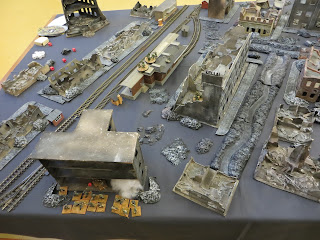Battle for Stalingrad No2 Railway Station
Following the failed Soviet Counterattack in the second battle the German forces quickly went back onto the offensive. The 21st Panzergrenadier Regiment had reached the Stalingrad No2 Railway Station and had gotten into close contact with the enemy.
 |
| Stalingrad No2 Railway Station with ruined Central Railway Hotel behind |
 |
| View facing north. German blinds coming from the west. |
The front line had a short no man's land along the railway tracks in the center but at either end the enemy forces were in very close proximity. The Russian player was allowed to place a unit in either the tall building on their left flank or the signal control offices west of the rail tracks on their right. In the end they chose to position their ex-conscript platoon from the previous battle (now rated as poor regulars having been 'blooded') in three floors of the tall building on the Russian left side. This unit I had given the nickname of Heroes Regiment troops. They were to experience some misfortune. The Germans were allowed to place units in both those advanced positions as well as anywhere on their side of no man's land. The German player placed an entire platoon of veteran pioneers in the tall building. He also put one of his recon blinds showing on there.
As a special rule for this battle I said that to mirror some reports of enemy combatants occupying different rooms and floors in the same building I allowed a situation where both sides had blinds within 4" of each other not to fight until one moved forward. The Germans got the first blinds card of the game and promptly moved forward their recon elements. In the tall building they immediately bumped the Heroes Regiment platoon which was forced to deploy on the table. Elsewhere the other two recon blinds moved forward into the railway station and uncovered two veteran squads from the 33rd Rifle Division.
 |
| German recon team spots soviet infantry defending No2 Railway Station |
 |
| The Heroes Regiment troops come to a sticky end. |
The sacrifice was great but they did succeed in killing 4 men in one pioneer squad including one of the two flamethrower teams, plus a man in each of the other two squads and they added bits of shock here and there. The flamethrowers also set fire to the building and the reduced pioneer squad spent the next several turns trying to fight the fire, with little success.
 |
| The two strongest pioneer squads vacate the burning building. |
 | ||||
| Soviet MMGs set up crossfire. The 1st pioneer squad is suppressed, the 2nd sets off a booby trap in a building. |
 |
| Flamethrower torches MMG team. |
The Russians activated a second veteran MMG team in the building in the third objective band behind. This caused 3 casualties but left the flamethrower team still
operational. They then promptly incinerated the MMG team, killing all
five members in a blizzard of fire.
 |
| Veteran Soviet platoon fails to prevent pioneers from capturing third line objective. |
As luck would have it the assault troops from the 399th battalion kept the initiative in the next turn by getting the first card and they used this to occupy the smoldering ruins that they had just flamed and as this was in the third objective line the German commander was content to limit his advances to this point. The Russian player asked whether he could get back the objective by throwing out the Germans but up until now we hadn't been playing it this way and so, with neither side wishing to risk any more troops, the game was called.
 |
| Pioneers retreat past burning building as German commander digs in on the railway line. |
 |
| The Soviets are penned into a tiny pocket up against the banks of the Volga. |
A resounding victory for the Wehrmacht but not without losses. The precious veteran pioneer platoon, perhaps the most powerful unit in the German core force roster, took nearly 70% casualties with only 10 men making it back to German lines. The Russians mourned the destruction of their Heroes Regiment troops but I wonder whether the loss of one of their two core veteran MMG teams won't be more problematic. All these troops may be badly missed for one reason or another by both sides in the climactic battle.
----------------------
We had some discussions after the game and came to the conclusion that I had generated an unsatisfactory set of objectives for the Germans that were a bit too close to their front line. And the German player had played within this stricture and the campaign rules and done the minimum necessary to get his objectives. My fault, not the player's, and we have come up with a better solution.
An attacker will still have three objective 'bands' that he needs to take a building in each of. He will now get half the points for the band when he first takes control of a building in any band BUT he will only get the other half of the points if he is still in possession of a building in a particular band at game end. That way a defender has an incentive to organise localised, in-game counter-attacks against a penetration by an attacker and the attacker has an incentive to commit extra troops to reinforce any gains made. All this I think encourages realistic tactics and behaviour and I was very pleased that we reached this rule change. Neither player has played with uncaring abandon. They have attacked when needed but both have also husbanded their forces when they had the opportunity. And all three of use are thoroughly enjoying ourselves.
Graham

















